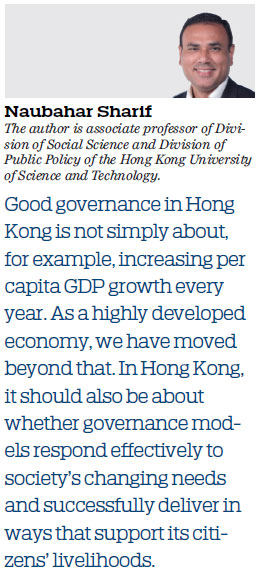Good governance comes from using the right indicators
Updated: 2019-05-08 07:38
By Naubahar Sharif(HK Edition)
|
|||||||
If a government is to execute its mandate, it must understand its citizens' wishes and concerns. To do so, valid and appropriate indicators should be made available to policymakers which will help them to execute policies and against which they can evaluate these policies following implementation.
Managing any society is a delicate task, and a government is typically required to act as an arbitrator between groups representing diverse interests and conflicting demands. In this context, a government must strike the right balance between the rights, desires and obligations of a multitude of stakeholders.

Since 1997, the Hong Kong economy has recorded modest but consistent rates of economic growth. In 1997, Hong Kong's GDP was HK$1.37 trillion ($175 billion). It grew by 3.5 percent on a compounded annual growth rate basis to HK$2.85 trillion in 2018. On a per capita basis, over the same period, Hong Kong's GDP grew from HK$211,590 per capita in 1997 to HK$381,870 per capita in 2018. While some may argue that these growth rates fall short of being stellar, they nevertheless reflect the resilience of Hong Kong's economy in the face of a series of shocks and crises experienced over the 1997-2018 period.
In the sphere of public finance, the SAR government spent HK$234.8 billion in 1997 and HK$575.4 billion in 2018. This reflects a compound annual growth rate in government expenditure of 4.4 percent - a figure that exceeds the annual compounded GDP growth rate of 3.5 percent. In 1997 the government's public expenditures accounted for 17.1 percent of its GDP that year, a figure that grew to 20.2 percent of GDP in 2018.
On the surface, these basic indicators suggest Hong Kong has made considerable social and economic strides since its return to China. These indicators also suggest that the government has been playing a more active role in Hong Kong's economy, as witnessed by its growing share of public expenditure as a percentage of GDP. That said, some segments of Hong Kong society remain deeply disaffected.
To obtain a more complete picture of the well-being of Hong Kong's citizenry, we must therefore move beyond widely touted economic indicators such as GDP and government expenditure; we must understand why some citizens express discontent. Achieving this goal requires a multipronged approach that identifies indicators that can give the government a better compass to lead its efforts.
Fortunately, in this regard, Hong Kong needs not to reinvent the wheel. The Organization for Economic Cooperation and Development (OECD) has been using the "Better Life Initiative" to gauge the quality of life in 41 countries since 2011. Through this initiative, the OECD has developed a comprehensive methodology that goes beyond economic indicators to understand and evaluate how its member nations are performing in terms of "well-being".
Indicators used in the "Better Life Initiative" fall into 11 categories and include, among others: household income, and household net wealth (in the "income and wealth" category); labor market insecurity, and job stress (in the "jobs and earning" category); housing affordability and rooms per person (in the "housing" category); working hours and time off (in the "work-life balance" category), life expectancy, and perceived health (in the "health status" category); educational attainment (in the "education and skills" category); social support (in the "social connections" category); voter turnout, and having a say in government (in the "civic engagement and governance" category); air quality, and water quality (in the "environmental quality" category); feeling safe at night (in the "personal security" category); and life satisfaction (in the "subjective well-being" category).
We believe that many of these guides would be extremely useful as measures of the progress that Hong Kong has made over the 21-year period of analysis, beyond GDP, government expenditure and the government's role in the economy.
Needless to say, the indicators used in the "Better Life Initiative" are open to criticism and scrutiny. Yet, widely used economic indicators are neither complete nor foolproof. By deploying the methodology of the OECD's "Better Life Initiative", Hong Kong's Census and Statistics Department could offer the SAR government a better perspective on the actual "well-being" of our citizens. Crucially, deploying such indicators would help the government both better understand why some citizens express dissatisfaction and identify areas needing attention.
Good governance in Hong Kong is not simply about, for example, increasing per capita GDP growth every year. As a highly developed economy, we have moved beyond that. In Hong Kong, it should also be about whether governance models respond effectively to society's changing needs and successfully deliver in ways that support its citizens' livelihoods.
If the indicators used in the "Better Life Initiative" are taken as seriously and used as widely as GDP and government expenditure, for instance, they could serve as useful tools to inform policymaking at the highest levels of the SAR government - in the chief executive's annual policy address and/or the financial secretary's annual budget.
Hong Kong's citizens clearly yearn for the government to be even more responsive and accountable than it currently is, keeping its citizens' wishes and concerns front-and-center. Using indicators that enable the government to best understand those wishes and concerns would be a good start toward achieving that objective.
(HK Edition 05/08/2019 page7)